ACT Science Practice Test 9
Bộ sưu tập: Tuyển Tập Bộ Đề Thi Đại Học Hoa Kỳ (ACT) - Có Đáp Án Chi Tiết
Số câu hỏi: 22 câuSố mã đề: 1 đềThời gian: 1 giờ
192,342 lượt xem 14,793 lượt làm bài
Metals differ in their relative abilities to conduct electricity. Resistance is a measurement in ohms (Ω) of how much a metal opposes electric current at a particular voltage.
A scientist performed 3 experiments using the circuit shown in Figure 1.
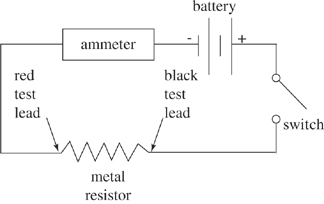
Figure 1
The metal resistor consisted of a coil of metallic wire with a known cross-sectional area and length (see Figure 2).
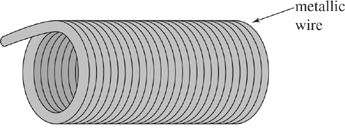
Figure 2
At the outset, the switch was open and no current flowed through the circuit. A 9-volt battery was used, and the black and red test leads of the circuit were attached to a metal resistor. When the switch was closed, electrons (negatively charged) flowed away from the negative battery terminal, through the circuit, and back to the positive battery terminal. The magnitude of current (charge per unit time) from this electron flow was measured by an ammeter, and was 1.0 × 10-3 coulombs/second for the first trial of each experiment. The resistance (R) of the metal resistor was calculated in ohms (?) from the resulting values for voltage (V) and current (I).
Experiment 1
Three nickel resistor coils, each with a cross-sectional area of 7.61×× 10-10 m2 but with different lengths, were attached separately to the circuit. Results were recorded in Table 1.
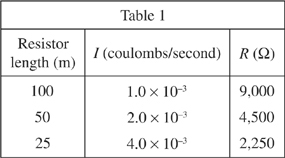
Experiment 2
Three gold resistor coils of varying cross-sectional areas were tested. Each resistor coil had a measured length of 100 m. The results were recorded in Table 2.
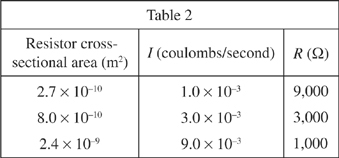
Experiment 3
Three coils made of different metals were tested. Each resistor had a cross-sectional area of 2.67 × 10-10 m2 and a length of 100 m. The value ρ is related to each metal's inherent resistivity to current flow. Results were recorded in Table 3.
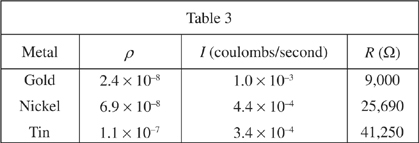
In Experiment 2, the scientist varied which of the following aspects of the metal resistor?
Identity of the metal coil
Cross-sectional area of the coil
Length of the coil
Value ρ
Assume that as ρ increases, a metal's ability to conduct current decreases. Based on the results of Experiment 3, which of the following correctly lists gold, nickel, and tin in order of increasing ability to conduct electrons when shaped as a wire coil?
Gold, nickel, tin
Gold, tin, nickel
Tin, nickel, gold
Tin, gold, nickel
In the first trial of Experiments 1-3, once the resistor was attached and the switch closed, what charge returned to the positive battery terminal each second?
-1.0×× 10-3
-2.0 ××10-3
-3.0×× 10-3
-4.0×× 10-3
Based on the results of the 3 experiments, the resistor with which of the following values of length, cross-sectional area, and metal type will have the highest current at a given voltage?
Length (m)
100
50
50
50
In Experiment 1, the current across the circuit increased and the resistance of the resistor decreased as the:
value ρ
cross-sectional area of the metal resistor decreased.
length of the metal resistor increased.
length of the metal resistor decreased.
When the switch is closed in the circuit described in the passage, the battery caused electrons to flow in the direction(s) shown by which of the following diagrams?
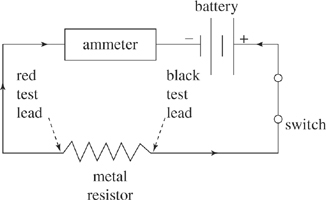
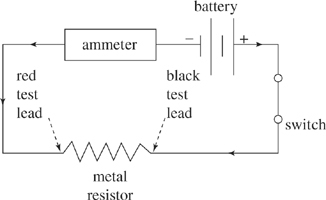
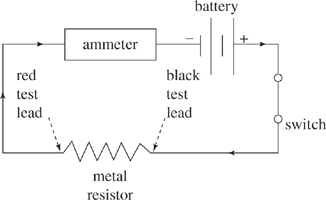
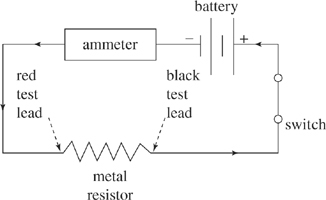
Pressure, temperature, volume, and amount of reactant are four variables that affect the rate at which a reaction in the gas phase occurs. A change in any of these variables changes the likelihood of particles running into each other and reacting: Increasing any one increases reaction rate; decreasing any one decreases reaction rate.
Pressure is measured in atmospheres, atm, where 1 atm is the sea level pressure of earth's atmosphere. Volume is measured in liters, L. The amount of reactant is measured in moles, where 1 mole is 6.02 × 1023 molecules.
Figure 1 shows how temperature and pressure affect the gaseous reactants in an experiment. Figures 2 and 3 show how the rate of Reaction A is affected by pressure and temperature, respectively.
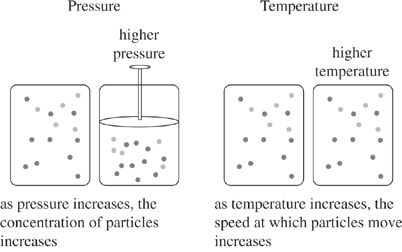
Figure 1
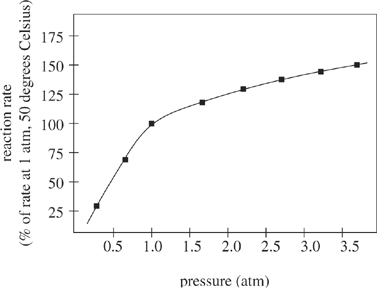
Figure 2
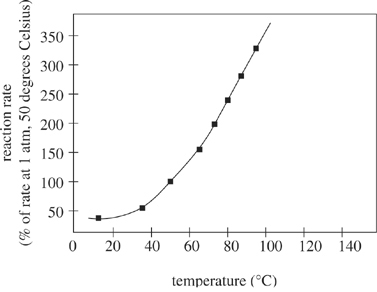
Figure 3
A scientist claimed that increasing temperature increases the rate at which Reaction A occurs and increasing pressure increases the rate at which Reaction A occurs. Is the scientist's claim supported by the passage and Figures 1-3?
Yes; the rate at which Reaction A occurred increased as temperature increased and increased as pressure increased.
Yes; the rate at which Reaction A occurred increased as pressure decreased.
No; the rate at which Reaction A occurred increased as temperature increased, but decreased as pressure increased.
No; the rate at which Reaction A occurred decreased as pressure increased.
According to Figures 2 and 3, the reactions occur at the same rate at what pressure and temperature?
20°C and 2.0 atm
40°C and 1.5 atm
50°C and 1.0 atm
70°C and 1.5 atm
The amounts of reactants in Reaction A are 1 mole/L of Compound Y and 2 mole/L of Compound Z. According to the passage, the number of molecules of Compound Y is:
one quarter of the number of molecules of Compound Z in the reactants.
one half the number of molecules of Compound Z in the reactants.
equal to the number of molecules of Compound Z in the reactants.
twice the number of molecules of Compound Z in the reactants.
A scientist tests a new Reaction B. This reaction is conducted with the same gas phase reactants, volume, pressure, and temperature as Reaction A, but the amounts (moles) of reactants are doubled. Based only on the information in the passage and Figures 1-3, how will the rate of Reaction B compare with the rate of Reaction A?
Reaction B will be slower than Reaction A because temperature will be lower.
Reaction B will be faster than Reaction A because temperature will be lower.
Reaction B will be faster than Reaction A because the concentration of reactants is greater, so the likelihood of reactant molecules colliding and reacting is greater.
Reaction B will be slower than Reaction A because the concentration of reactants is greater, so the likelihood of reactant molecules colliding and reacting is greater.
A chemist wanted to measure Reaction A at the greatest possible reaction rate. She had the ability to change either the temperature or the pressure of the gaseous reactants. Based on the data in Figures 2 and 3, which property did she most likely alter to increase the rate of Reaction A?
Pressure, which she decreased from 1 atm to 0.5 atm
Pressure, which she increased from 1 atm to 3 atm
Temperature, which she decreased from 50°C to 20°C
Temperature, which she increased from 50°C to 100°C
An experiment is set up to look at the physics of bouncing a ball, as shown in Figure 1.
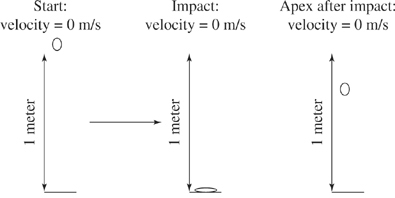
Figure 1
When the ball is dropped, its initial velocity is 0 m/s. Velocity will increase until impact with the ground, at which point the ball's velocity immediately drops to 0 m/s again. After impact, velocity almost immediately increases to maximum post-impact velocity, and then begins to fall again as gravity works against it, slowing it down. The ball's velocity returns to 0 m/s when the ball is at its apex, or highest vertical point, post impact.
When a ball bounces, it deforms and becomes flatter. This is called elasticity. The more elasticity a material has, the better it is able to act like a spring and absorb force by being compressed, then use this force to "spring" back into the air. Post-impact velocity and the amount of time between velocity of 0 m/s at impact and velocity of 0 m/s at post-impact apex are affected by elasticity. Figure 2 shows the velocity of a ball versus time for balls with various elasticities and weights dropped from 1 meter height. Because gravity causes all objects to fall at the same speed regardless of weight, pre-impact velocities are identical for all balls.
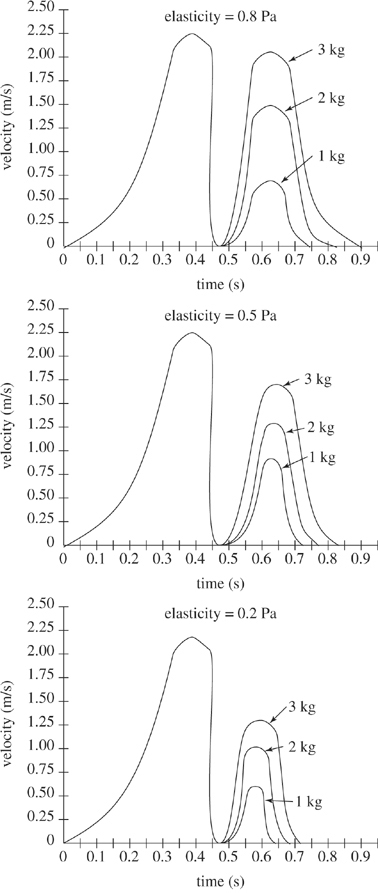
Figure 2
Based on the data in Figure 2, the maximum post-impact velocity of a ball will be smallest if the elasticity of the ball is:
1.5 Pa.
between 1 and 1.5 Pa.
between 0.5 and 1 Pa.
0.5 Pa.
Based on the information in Figure 2, a ball being dropped from 1 meter height with an elasticity of 0.2 Pa and a weight of 0.5 kg would have a maximum post-impact velocity of:
less than 0.50 m/s.
0.75 m/s.
1.0 m/s.
greater than 1.25 m/s.
Consider a ball as it completes one bounce, from drop to post-impact apex. If this ball has a weight of 2 kg and an elasticity of 0.50 Pa, based on the data in Figure 2, how many times does the ball have a velocity of 1.00 m/s ?
One time
Two times
Three times
Four times
Based on the data in Figure 2, how does the velocity of a ball change as it goes from impact to apex?
Drop to Impact
Increases only
Decreases only
Increases then decreases
Decreases then increases
A ball will deform permanently and not spring back off the ground if the velocity with which it hits the ground exceeds the ball's elastic limit. Based on the data in Figure 2, if a ball is dropped from one meter and has a weight of 3 kg, an elasticity of 0.8 Pa, and an elastic limit of 2.75 m/s, will the ball deform permanently?
Yes, because the velocity with which the ball hits the ground is less than its elastic limit.
Yes, because the velocity with which the ball hits the ground is greater than its elastic limit.
No, because the velocity with which the ball hits the ground is less than its elastic limit.
No, because the velocity with which the ball hits the ground is greater than its elastic limit.
A group of students studied the frictional forces involved on stationary objects.
In a series of experiments, the students used rectangular shaped objects of various materials that all had identical masses. One end of a plastic board coated with a polymer film was fastened to a table surface by a hinge so the angle θ between the board and table could be changed, as shown in Figure 1.
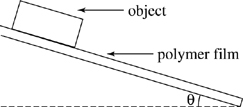
Objects were placed on the opposite end of the board, and the angle θ at which the object started to slide was recorded. The tangent of this angle represents the coefficient of static friction between the object and the polymer surface. This coefficient is proportional to the force required to move a stationary object. Higher coefficients mean that greater forces of friction must be overcome to initiate movement.
The dimensions of the objects gave them 3 distinct faces of unequal area as shown in Figure 2. Unless otherwise stated, the objects were placed on the ramp with Face A down.
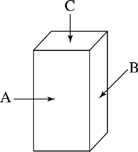
Experiment 1
Four objects made of different materials were placed on the ramp at a temperature of 25°C. The ramp was gradually raised and as soon as the object started to move, the angle θ of the ramp was recorded in Table 1.
| Table 1 | |
| Object material | θ (degrees) |
| Granite | 12.1 |
| Copper | 16.8 |
| Wood | 22.0 |
| Brick | 31.1 |
Experiment 2
The procedure for Experiment 1 was repeated with the wooden object, varying which face was placed down on the ramp. Results were recorded in Table 2.
| Table 2 | |
| Face | θ (degrees) |
| A | 22.0 |
| B | 22.0 |
| C | 22.0 |
Experiment 3
The procedure for Experiment 1 was repeated with the wooden object, varying the temperature of the polymer ramp. Results for 5 temperatures were recorded in Table 3.
| Table 3 | |
| Temperature (°C) | θ (degrees) |
| 0 | 18.5 |
| 25 | 22.0 |
| 50 | 25.4 |
| 75 | 29.0 |
| 100 | 32.5 |
Experiment 4
The procedure for Experiment 1 was repeated with multiple wooden objects. For each trial, the objects were stacked on top of each other before raising the ramp. The angle θ where the stack started to slide was recorded in Table 4.
| Table 4 | |
| Number of objects | θ (degrees) |
| 2 | 22.0 |
| 3 | 22.0 |
| 4 | 22.0 |
If the procedure used in Experiment 3 had been repeated at a temperature of 62.5°C, the angle required for the object to start moving down the ramp most likely would have been closest to which of the following?
27.2 degrees
29.2 degrees
30.3 degrees
31.4 degrees
Suppose the students had placed the 4 objects used in Experiment 1 on the ramp when it was flat and pushed each of the objects, such that the amount of force applied to each object gradually increased until it moved. Based on the results of Experiment 1, the object made of which material would most likely have taken the greatest amount of force to start moving?
Brick
Wood
Copper
Granite
Based on the results of Experiments 1 and 4, what was the effect, if any, of the weight of the object on the coefficient of static friction?
The coefficient of static friction always increased as the object's weight increased.
The coefficient of static friction always decreased as the object's weight increased.
The coefficient of static friction increased and then decreased as the object's weight increased.
The coefficient of static friction was not affected by the weight of the object.
In Experiment 1, the reason the students used objects made of different materials was most likely to vary the amount of frictional force between the:
plastic board and the polymer surface.
various objects and the polymer surface.
objects made of different materials when brought into contact with each other.
stacked objects, so that the objects would not fall over when the angle of the ramp was raised high enough to cause motion.
Which of the following ranks the different types of objects used, in order, from the material that presented the greatest resistance to movement to the material that presented the least resistance to movement?
Granite, copper, wood, brick
Copper, wood, granite, brick
Granite, wood, brick, copper
Brick, wood, copper, granite
The main purpose of Experiment 3 was to determine the effects of temperature on which of the following variables?
Coefficient of static friction between wood and wood
Coefficient of static friction between wood and polymer
Mass of the wooden object
Total frictional force of the polymer on all objects placed on the ramp
1 mã đề 22 câu hỏi
1 mã đề 11 câu hỏi
1 mã đề 22 câu hỏi
1 mã đề 13 câu hỏi
1 mã đề 30 câu hỏi

